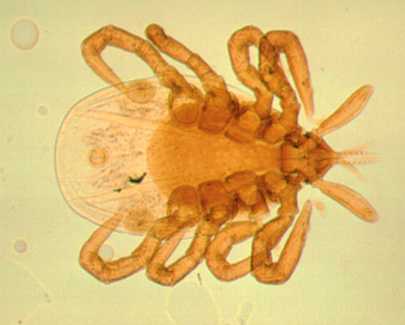Arachnids
 |
Ixodes scapularis. Nymphal tick
(unstained, low power). These ticks are often found attached to the skin, removed,
and brought to the laboratory for identification because of the concern about
possible disease transmission. This tiny tick is known as the deer tick and
transmits Babesia microti and Lyme disease (borreliosis caused by Borrelia
burgdorferi) in the United States. This species is prevalent in the northeastern
United States as far south as Virginia and also in the Midwest. One form of
this species lives in the South and southwestern United States. Another closely
related species, Ixodes pacificus, is found on the west coast of the
United States. Adult female I. scapularis are 2.3 to 2.7 mm long by 1.5
to 1.6 mm in breadth; adult males are smaller, 1.8 to 2.1 mm long by 1.0 to
1.3 mm. The ticks have a 2-year life cycle, which includes a six-legged larval
stage and eight- legged nymphal and adult stages. The larval and nymphal stages
feed primarily on small rodents and the adult ticks usually feed on deer or
other large mammals. The nymphal stage appears to be the most important stage
in transmission of diseases to humans. Nymphs measure 1.1 to 1.9 mm long by
0.7 mm in breadth. Larvae measure 0.5 to 0.6 mm long by 0.4 to 0.5 mm. The nymph
in this ventral view shows the prominent toothed hypostome and the palpi flanking
it.

